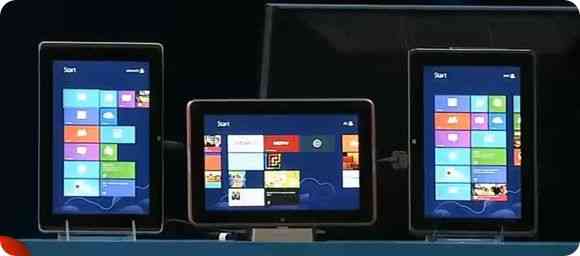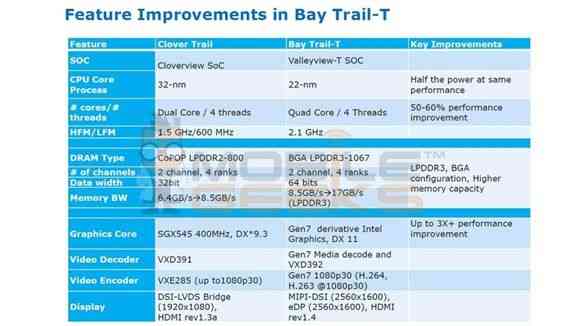Intel just introduced Bay Trail, the next-generation platform for Windows 8 which should bring devices by ‘Holiday of 2013’
Compal, Pegatron and Wistron designs were shown on stage. Availability of quad-core platform: Holiday of 2013
Press release information.
Tablet Roadmap Expanded with upcoming Quad-Core Intel® Atomâ„¢ Processor
Speaking to a robust product roadmap and growing ecosystem of tablet and tablet convertible devices running on Intel technology, Bell reinforced the wide range of tablet designs based on the Atom Processor Z2760 running Windows2 8 now on shelves and online from OEMs such as Acer*, ASUS*, Dell*, Fujitsu*, HP*, Lenovo*, LG* and Samsung*. More tablet designs are scheduled to ship over the coming weeks. Enabling a mobile, connected and full Windows2* 8 experience, the Atom platform boasts all-day battery life and is more power- efficient than competitive offerings.
He also unveiled details about the company’s next-generation 22nm Atom SoC, codenamed “Bay Trail,” which is already booting and scheduled to be available for holiday 2013. The first quad-core Atom SoC will be the most powerful Atom processor to date, delivering more than two times the computing performance of Intel’s current generation tablet offering. It will also include new improved integrated security offerings. These improvements will enable new experiences for business and personal use in devices as thin as 8mm that have all-day battery life and weeks of standby, all at lower prices.
“With Bay Trail we will build on the work done with our current SoC development and accelerate very quickly by leveraging Intel’s core computing strengths,” Bell said. “We will take advantage of the tremendous software assets and expertise at our disposal to deliver the best products with best-in-class user experiences.”
Bay Trail details from leaked documents
Bay Trail is the next generation, 22nm-based Atom architecture and it’s a big change. Leaked roadmaps mention a 2014 availability (1st Quarter) so don’t get too excited just yet but some of the details are very interesting. You’ll see a higher TDP but don’t worry because there’s a lot more on-board here including a variant of Intel’s graphics unit. A move away from PowerVR means better control over drivers and hope for Linux fans!
The SoC is known as Valleyview-T (where Clovertrail used a Cloverview SoC) and it will offer up to 4 cores. Display support will be improved above 1920×1080 and the graphics could be much more powerful. We expect huge improvements in media encoding and decoding efficiency and speed. Storage will still be eMMC based but USB3.0 support will be added.
With Intel’s Haswell platform reaching down into 8W TDP space and Bay Trail reaching up where Pentiums and Celeron processors were operating a few years ago there’s little space left for these brands. Haswell will also offer Connected Standby features so there’s a possibility that there will be a crossover of platforms in the 10-12.5-inch space with ‘Pro’ tablets offering true desktop capability and the consumer tablets focusing on style, weight, value and mobility.
Bay Trail leaked information via MobileGeeks.













Its going to be hard to choose between Bay Trail and Haswell this holiday season!
Yeah, very although I see one being in-home / hot desk portable and the other being a totally mobile pc. Have to have both!
Very much the right moves except for eMMC only storage. The storage PERF is already a pretty huge bottle neck on app launches and the over-all experience on CloverTrail-based Win8 x86 platforms. The EXPERIENCE needs high perf storage.
These small screen tablets and convertibles can actually multitask with Win8 and a CRYING OUT for WIDI, though; Intel needs to let Atom off of it’s chain and fill that consumer demand. (But they want to hold onto those 60% Core profit margins…)
Their VISION for ultrabooks is great, but it’s not going to do what they want if it’s powered by a 60% profit margin Core CPU. They’re going to have to give up profit margin to get growth and market share. The whole industry NEEDS them to do it so it’s not a one horse tablet race.
Adam
Efjay,
IF the Atom platform FEATURES weren’t being held back, it would be SOO easy to choose. Bay Trail CPU and GPU performance will be more than “good enough” for the overwhelming majority of requirements especially when you consider that even the apps that are today considered to “NEED” the hardware today will be forced to work better with lower hardware requirements; in the app-focused world your app needs to be written to lowest common denominator hardware to sell in huge volumes.
We’re going to see big apps rewritten to be more efficient and other than just being a performance nut / enthusiast, Bay Trail is “enough” for most people; the artificial castration of several features is what will make it hard.
Intel need to quit worrying about competing with themselves and worry about competing with ARM; worry about being left out of the tablet game entirely. Intel’s biggest advantage is x86 compatibility and app compatibility when Windows is run on their devices –they need to be an efficiency, feature, AND cost competitor to ARM. -A 10% premium over ARM CPUs can be completely supported; hell just x86 app and driver compat might be worth that much alone.
Let the Core CPUs continue to support the legacy and evolving PC business and what the heck -go ahead and keep the 60% profit margins there; no one cares there. Atom needs to stretch its legs and go get ARM quit holding it back for the love of God. (They’re winning the battle and losing the war because their strategy is wrong.) -Turn that big ass boat, Intel! Put all oars in the water and turn it around NOW! Launch Bay Trail with everything: SATA support WIDI 3.5 + Miricast and launch it with a magic “wireless display out” gesture.
-Hell, launch a premium Intel branded tablet along with Bay Trail -exclusive apps, exclusive content, and drop-dead SEXY -pull your extra profit from there; grab some profit from wherever you can but that device’s selling price has to compete with ARM selling prices.
Adam
When Atom costs less than half the price of Haswell, is sexier, and works with the hardware and software you want with longer battery life; there’s no reason for the mainstream consumer to look at ARM or Haswell.
“One-Device-to-Rule-Them-All” is within their grasp. No clunky laptop + a consumption tablet required; backwards compat, ability to actually work, and fantastic for consumption and play. -With a price that’s fully justified.
They have to make the decision of Elsa at the end of Indiana Jones and the Temple of Doom -they can try to grasp just a little harder for that golden cup (and fall to their death), or they can let it go and realize that only by letting the one treasure go can they get the treasure that’s more dear. Their name can become a byword added to a long list of has-beens, or can be associated with a huge transition and comeback and do best at what they do best.
It’s so painful to watch this possible train-wreck in slow motion…
Adam
Any tablet that doesn’t have Miracast support Holiday 2013 is going to look ridiculously out-of-date. It’s the only part of modern mobile computing that requires wires, and it’s awkward.
Adam